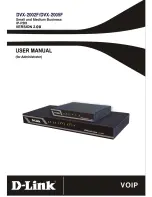
5.
Transfer Recall to a Mailbox of the VPS
If a call is transferred to an extension via the Automated Attendant (AA) service of the VPS and the call is
not answered within a preprogrammed Transfer Recall time, the PBX sends the mailbox number of the
transfer destination extension to the VPS. Therefore the caller can leave a message in the mailbox of the
extension without knowing the mailbox number. The "
Transfer Recall to Mailbox
" setting should
be enabled through system programming to use this feature.
4.5 [2-3] Timers & Counters—Dial / IRNA / Recall / Tone—
5.18 [3-7-1] VM(DPT) Group—System Settings—
®
6.
Listening to a Recorded Message (Direct Mailbox Access)
If the VPS receives a message, the VPS will set the Message Waiting feature (e.g., turning on the Message
button light, and showing the number of messages waiting on the display of a 6-line display PT) on the
corresponding telephone as notification. (
®
11.1.3 Message Waiting) Thereby, the VPS notifies the
extension user that there is a message waiting in his mailbox. When the Message button light turns on,
pressing the button allows the extension user to play back the messages stored in his mailbox without
dialing such as a mailbox.
When the extension user dials an extension number of the VM (DPT) extension port or the floating
extension number of the VM (DPT) group from his extension, he can listen to the messages stored in his
mailbox without dialing his mailbox number (Direct Mailbox Access). It is possible to disable this feature
by COS programming on the VPS.
7.
VPS CO Line Service & Automatic Time Mode Notification for Incoming Call
Multiple tenants can share a single VPS; each tenant does not require a dedicated VPS port. If the
destination of the incoming CO line call is a VM (DPT) group, the PBX sends the VM trunk group number
and time mode (day/lunch/break/night) of the tenant (
®
17.1.5 Time Service) assigned for the call to the
VPS. Therefore the VPS can send the assigned message (company greeting) to the caller. Corresponding
VM trunk group number and tenant number are determined by the setting of the incoming CO line call as
follows:
a.
DIL/TIE:
the setting of each CO line port (
®
®
FEATURES)
12.2 [10-2] DIL Table & Port Settings—DIL
→
→
b.
DID:
the setting of each location number for DID (
®
4.1.6 DID (Direct Inward Dialing))
→
→
Document Version 2013-05
Feature Manual
365
19.1.4 Voice Mail DPT (Digital) Integration
Summary of Contents for KX-NCP500
Page 13: ...Section 1 Features and Configurations A Document Version 2013 05 Feature Manual 13...
Page 27: ...Section 2 Features and Configurations B Document Version 2013 05 Feature Manual 27...
Page 30: ...30 Feature Manual Document Version 2013 05 2 1 1 BGM Background Music...
Page 31: ...Section 3 Features and Configurations C Document Version 2013 05 Feature Manual 31...
Page 75: ...Section 4 Features and Configurations D Document Version 2013 05 Feature Manual 75...
Page 100: ...100 Feature Manual Document Version 2013 05 4 1 12 Doorphone Call...
Page 101: ...Section 5 Features and Configurations E Document Version 2013 05 Feature Manual 101...
Page 112: ...112 Feature Manual Document Version 2013 05 5 1 9 External Sensor...
Page 113: ...Section 6 Features and Configurations F Document Version 2013 05 Feature Manual 113...
Page 135: ...Section 7 Features and Configurations G Document Version 2013 05 Feature Manual 135...
Page 140: ...140 Feature Manual Document Version 2013 05 7 1 1 GROUP FEATURES...
Page 141: ...Section 8 Features and Configurations H Document Version 2013 05 Feature Manual 141...
Page 149: ...Section 9 Features and Configurations I Document Version 2013 05 Feature Manual 149...
Page 185: ...Section 10 Features and Configurations L Document Version 2013 05 Feature Manual 185...
Page 193: ...Section 11 Features and Configurations M Document Version 2013 05 Feature Manual 193...
Page 204: ...204 Feature Manual Document Version 2013 05 11 1 5 Mute...
Page 205: ...Section 12 Features and Configurations O Document Version 2013 05 Feature Manual 205...
Page 212: ...212 Feature Manual Document Version 2013 05 12 1 5 Operator Features...
Page 213: ...Section 13 Features and Configurations P Document Version 2013 05 Feature Manual 213...
Page 296: ...296 Feature Manual Document Version 2013 05 13 1 32 PT Programming...
Page 297: ...Section 14 Features and Configurations Q Document Version 2013 05 Feature Manual 297...
Page 301: ...Section 15 Features and Configurations R Document Version 2013 05 Feature Manual 301...
Page 307: ...Section 16 Features and Configurations S Document Version 2013 05 Feature Manual 307...
Page 332: ...332 Feature Manual Document Version 2013 05 16 1 10 Syslog Record Management...
Page 333: ...Section 17 Features and Configurations T Document Version 2013 05 Feature Manual 333...
Page 354: ...354 Feature Manual Document Version 2013 05 17 1 6 TRS Toll Restriction...
Page 355: ...Section 18 Features and Configurations U Document Version 2013 05 Feature Manual 355...
Page 357: ...Section 19 Features and Configurations V Document Version 2013 05 Feature Manual 357...
Page 379: ...Section 20 Features and Configurations W Document Version 2013 05 Feature Manual 379...
Page 388: ...388 Feature Manual Document Version 2013 05 20 1 5 Wireless XDP Parallel Mode...
Page 389: ...Section 21 Appendix Document Version 2013 05 Feature Manual 389...
Page 415: ...Index Document Version 2013 05 Feature Manual 415...
Page 421: ...Document Version 2013 05 Feature Manual 421 Notes...












































